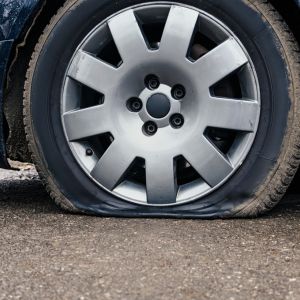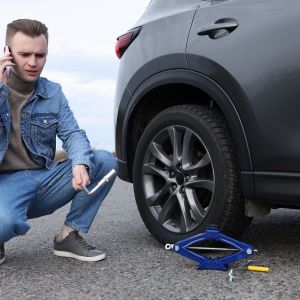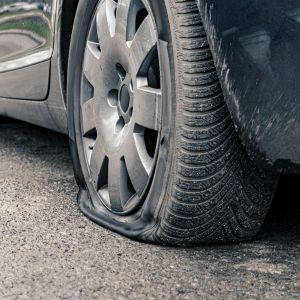A punctured tyre should be replaced as soon as possible. A punctured tyre can be dangerous for several reasons. A puncture or a damaged tyre is a reason for several road accidents. When a tyre is punctured, it loses its air pressure and becomes under-inflated, which can affect the driving and control of the vehicle. It increases the risk of a blowout or a loss of control, which can lead to accidents and injuries. So, you should know the best time to replace a tyre after a puncture.
How to know if the tyre is punctured?

There are various indications in case a tyre is punctured. These are:
- Low air pressure in the tyre: A punctured tyre will lose air pressure, so if the tyre pressure monitoring system (TPMS) or manual tyre pressure gauge indicates that one or more tyres are under-inflated, it possibly means that there is a puncture.
- The uneven surface of the tyre: A punctured tyre can cause uneven wear and tear on the tyre. These weary marks can sometimes cause serious damage to the tyre.
- Unusual noise and vibration: When a tyre is punctured, it usually creates a humming or whistling noise, especially when the vehicle is moving at a high speed.
- Slow and gradual leaking: A punctured tyre slowly loses its air pressure, and the driver may not be able to detect it immediately. It can be seen by the gradual decrease in the tyre pressure.
- Visible puncture: A puncture can be visible if the hole in the tyre is significantly bigger in size.
It’s important to regularly check the air pressure, inspect the tyres for any signs of damage, and address any issues that are found as soon as possible to ensure the safety of the vehicle and the driver.
When should we replace a tyre after a puncture?

A punctured tyre should be replaced as soon as possible to ensure the safety of the vehicle and the driver. Following are a few key factors to consider while determining when to replace a tyre after a puncture:
- Size of the puncture: If the puncture is larger than 6mm, the tyre is considered unrepairable and must be replaced. A small puncture can be repaired, but tyres with bigger tears should be replaced immediately.
- Location of the puncture: If the puncture is located on the sidewall of the tyre, it can’t be repaired and must be replaced immediately.
- Age of the tyre: If a tyre is old and worn, it may be more cost-effective to replace it rather than repair it, even if the puncture is small.
- The severity of the puncture: The tyre must be replaced when the puncture is severe, as it can cause irreparable damage to the vehicle.
- The number of punctures: If a tyre has multiple punctures, it may be more cost-effective to replace the tyre rather than repair it multiple times.
Is it safe to drive with a punctured tyre?

We should not drive a vehicle with a punctured tyre because it can cause severe accidents and can cause serious injuries to the driver. It is not safe to drive a vehicle with a punctured tyre. A punctured tyre can lose air pressure, which can affect the driving and handling of the vehicle. This can lead to accidents and injuries, and it can cause damage to the wheel and tyre.
A punctured tyre can also create a dangerous situation for other drivers on the road. It is important to get a punctured tyre inspected by a professional flat tyre repair service provider and get repaired or replaced as soon as possible to avoid any dangerous situation. If you have a punctured tyre, it is better to stop driving as soon as it is safe to do so.
Frequently Asked Questions
Q1. When should a punctured tyre be replaced?
Ans: A punctured tyre should be replaced as soon as possible. It is quite dangerous to drive a vehicle with a flat tyre. It has the potential to cause accidents and irreparable damage to the tube and tyre
Q2. How long do tubeless tyres last after a puncture?
Ans: The tubeless tyre has a lifespan of several months to a year after a puncture. It is usually determined by the size of the puncture and the number of times it has occurred. It is advised to check with a professional mechanic before replacing the tyre.
Q3. Do I need a new tyre if I have a nail in it?
Ans: Yes, generally, it is not safe to repair a tire with a nail in it. To ensure your safety, it is best to replace the tyre because certain objects can cause severe damage to the tyre and cause problems in the future.
Q4. How long can you drive on a tyre with a slow puncture?
Ans: A tyre with a slow puncture should be checked and repaired as soon as possible. It is not safe to drive for an extended period on a tyre with a slow puncture.
Q5. Can I drive for 2 minutes on a flat tyre?
Ans: No, you should not drive a vehicle with a flat tyre It is not safe to drive for even two minutes on a flat tyre.
Q6. Can I drive for 5 minutes with a flat tyre?
Ans: No, you should not drive a vehicle with a flat tyre. as it is not safe to drive for even five minutes with a flat tyre.
Q7. Is it better to drive fast or slow on a flat tyre?
Ans: It is best not to drive at any speed on a flat tyre because it can cause accidents and damage to the wheel and tyre. It can be very dangerous to the driver and other road users.
Q8. Can you pump a flat tyre?
Ans: Yes, you can pump a flat tire. You will need to locate the valve stem, remove the valve cap, and use a tire pump to inflate the tire. Depending on the type of tire pump, you may need to press the pump onto the valve stem to secure it before you can begin to pump air into the tire.

